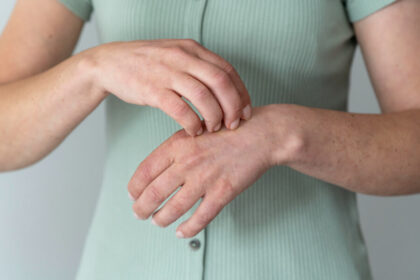Psoriasis is a chronic skin condition characterized by the rapid and excessive growth of skin cells.
This leads to the accumulation of thick, red, and scaly patches on the skin’s surface.
It is an autoimmune disorder, which means that the immune system mistakenly targets the body’s own skin cells, causing inflammation and the overproduction of skin cells.
It is a chronic condition, meaning it can persist for a long time, and it often goes through periods of remission and exacerbation.
Types
It is a complex skin condition with several different types, each characterized by distinct symptoms and appearances.
The most common types include:
Plaque Psoriasis (Psoriasis Vulgaris)
Plaque psoriasis is the most common form, accounting for about 80% of psoriasis cases.
It is characterized by raised, inflamed, red patches of skin covered with silvery-white scales (plaques).
These plaques can appear anywhere on the body, but they often occur on the elbows, knees, lower back, and scalp.
Guttate Psoriasis
It typically starts in childhood or young adulthood and is often triggered by a bacterial infection, such as strep throat.
It presents as small, drop-like red lesions on the skin.
Guttate psoriasis may resolve on its own or develop into other forms of psoriasis.
Inverse Psoriasis
It affects skinfolds, such as under the breasts, in the groin area, or in armpits.
It appears as smooth, red, and inflamed patches without the typical scales seen in plaque psoriasis.
Pustular Psoriasis
It is characterized by white, pus-filled blisters (pustules) surrounded by red skin.
There are several subtypes of it, including palmoplantar pustulosis and generalized pustular psoriasis.
Erythrodermic Psoriasis
It is a severe and rare form that can cover the entire body with a fiery red rash.
It can cause widespread shedding of skin and may be life-threatening if not treated promptly.
Nail Psoriasis
This type affects the nails, causing changes in their appearance, such as pitting, discoloration, thickening, and separation from the nail bed.
It can occur in conjunction with other forms of the disease.
Psoriatic Arthritis
It is a type of inflammatory arthritis that affects some individuals with psoriasis.
It can cause joint pain, stiffness, and swelling, often leading to joint damage if not managed.
These are the main types, but it’s worth noting that some individuals may experience a combination of different types, and the severity of the condition can vary from person to person.
Symptoms
The symptoms can vary depending on the type of psoriasis and its severity.
The most common symptoms include:
Red, Inflamed Skin
It often presents as raised, red patches of skin.
The affected areas can be itchy and painful.
Silvery-White Scales
These patches of red skin are typically covered with silvery-white scales, which can flake off.
Dry and Cracked Skin
The affected skin may become dry, and it can crack or bleed in severe cases.
Itching and Discomfort
It can be intensely itchy and uncomfortable, leading to irritation and distress.
Thickened or Pitted Nails
Nail psoriasis can cause changes in the nails, such as pitting (small dents), thickening, discoloration, or separation from the nail bed.
Joint Pain and Swelling
For individuals with arthritis, joint symptoms can include pain, swelling, and stiffness in the affected joints.
Burning or Soreness
Some people may experience a burning or sore sensation in the affected areas.
Lesions with Well-Defined Borders
Psoriasis lesions often have well-defined borders that distinguish them from the surrounding skin.
Skin Discoloration
In some cases, it can cause areas of skin to become darker (hyperpigmentation) or lighter (hypopigmentation) than the surrounding skin.
Scalp Psoriasis
When psoriasis affects the scalp, it can lead to red, scaly patches, dandruff-like flaking, and itching.
Inverse Psoriasis
In skinfold areas, such as the groin, under the breasts, and in armpits, it can appear as smooth, red patches without scales.
It’s important to note that it is a chronic condition that often goes through periods of remission and exacerbation.
The severity and extent of symptoms can vary greatly from person to person.
Some individuals may have relatively mild, localized psoriasis, while others may experience more widespread and severe symptoms.
Causes
The exact causes are not fully understood, but the condition is believed to result from a combination of genetic, immune system, and environmental factors.
Here are some of the key factors that are thought to contribute:
Genetics
It tends to run in families, suggesting a genetic predisposition.
Specific genes associated have been identified, and having a family history of the condition increases the risk of developing it.
Immune System Dysfunction
It is considered an autoimmune disorder, which means the immune system mistakenly targets healthy skin cells.
T cells, a type of white blood cell, are thought to play a central role in this immune system malfunction.
Environmental Triggers
Various environmental factors can trigger or exacerbate psoriasis in individuals with a genetic predisposition.
Common triggers include infections (such as strep throat), skin injuries (cuts, scrapes, or sunburn), stress, smoking, and certain medications (such as beta-blockers or lithium).
Immunological Changes
It is associated with an overproduction of certain proteins and cytokines (cell signaling molecules) in the skin.
These substances can lead to inflammation and the accelerated growth of skin cells.
Hormonal Changes
Some women experience changes in their psoriasis symptoms during pregnancy or menopause, suggesting a hormonal component in the development of psoriasis.
Lifestyle Factors
Lifestyle choices, such as smoking and excessive alcohol consumption, have been linked to an increased risk of developing psoriasis or worsening its symptoms.
It’s important to note that psoriasis is a complex and multifactorial condition, and not all individuals with a genetic predisposition will develop the condition.
Additionally, the severity and course of psoriasis can vary greatly from person to person.
While the exact causes of psoriasis are not fully known, researchers continue to study the condition to gain a better understanding and improve treatment options.
Psoriasis flare-ups
Psoriasis flare-ups, also known as exacerbations or flare-ups, are periods during which the symptoms become more severe, causing a sudden and noticeable worsening of the condition.
These flare-ups can vary in intensity and duration, and they can be triggered by a variety of factors.
Here’s what you should know about psoriasis flare-ups:
Triggers
The flare-ups can be triggered by a range of factors, including:
- Stress: Emotional stress is a common trigger for many individuals.
- Infections: Bacterial or viral infections, such as strep throat, can lead to it.
- Skin Injuries: Cuts, scrapes, burns, or excessive scratching can lead to new lesions.
- Medications: Certain medications, such as beta-blockers and lithium, can trigger or worsen the condition.
- Weather: Cold, dry weather can dry out the skin, potentially triggering flare-ups.
- Alcohol and Smoking: Excessive alcohol consumption and smoking are known to exacerbate symptoms in some individuals.
Symptoms
During a flare-up, the typical symptoms become more pronounced.
This may include increased redness, inflammation, thicker plaques, greater itchiness, and more widespread involvement of the skin.
Duration
The duration of flare-ups can vary widely. Some may be short-lived, lasting a few days or weeks, while others can persist for several months.
Severity
The severity of a flare-up can range from mild to severe, and the impact on an individual’s quality of life can vary accordingly.
Severe flare-ups can be particularly distressing and may require more intensive treatment.
Treatment
The management of flare-ups often involves adjusting the treatment plan.
This may include using topical corticosteroids, phototherapy, or systemic medications to control symptoms and reduce inflammation.
Prevention
Recognizing and avoiding trigger factors is essential for preventing or minimizing flare-ups.
This may involve stress management, proper wound care to prevent skin injuries, and avoiding known trigger medications.
Individual Variation
It’s important to note that flare-ups are highly individualized.
What triggers a flare-up in one person may not affect another.
Additionally, the effectiveness of treatment during a flare-up can vary from person to person.
Treatments
The treatment aims to manage and alleviate its symptoms, reduce inflammation, slow down skin cell growth, and improve the overall quality of life for individuals with the condition.
Treatment options can vary based on the type and severity of psoriasis, as well as individual preferences. Here are some common treatment approaches for psoriasis:
Topical Treatments
- Emollients: These moisturizers help keep the skin hydrated, which can reduce dryness and itching.
- Topical Corticosteroids: These anti-inflammatory creams or ointments can help reduce redness, itching, and inflammation in mild to moderate psoriasis.
- Topical Vitamin D Analogues: These medications slow down the growth of skin cells and can be effective for treating psoriasis lesions.
- Topical Retinoids: Derived from vitamin A, retinoids can be used to treat psoriasis and promote skin cell turnover.
- Topical Calcineurin Inhibitors: These immunosuppressive agents are used for sensitive areas like the face and can help reduce inflammation.
Phototherapy (Light Therapy)
Ultraviolet (UV) light therapy, either with UVA or UVB light, is used to slow skin cell growth and reduce inflammation.
It is often effective for treating mild to moderate psoriasis.
Phototherapy can be administered under medical supervision in clinics or with home UVB devices.
Systemic Medications
These are prescription medications taken orally or by injection and are reserved for moderate to severe psoriasis or cases that do not respond to other treatments.
Systemic treatments include oral retinoids, methotrexate, cyclosporine, and biologic drugs (e.g., TNF-alpha inhibitors, interleukin inhibitors).
Biologics
Biologic drugs are a newer class of medications that target specific components of the immune system responsible for psoriasis.
They are typically reserved for moderate to severe psoriasis and can provide significant symptom relief.
Apremilast
Apremilast is an oral medication that works as an anti-inflammatory agent and is approved for the treatment of psoriasis.
Psoralen Plus Ultraviolet A (PUVA) Therapy
PUVA therapy combines the use of a light-sensitizing medication (psoralen) with UVA light exposure.
This is generally reserved for severe cases of psoriasis.
Lifestyle and Dietary Changes
Maintaining a healthy lifestyle, including managing stress, quitting smoking, and reducing alcohol consumption, can help improve psoriasis symptoms.
Some individuals find relief by identifying and avoiding trigger factors in their diet.
Complementary and Alternative Therapies
Some people with psoriasis explore complementary therapies like acupuncture, dietary supplements, and herbal remedies.
Consult with a healthcare professional before trying these options.
10 Tips for Managing
Here are ten tips to help you manage and improve your quality of life:
Consult a Dermatologist
A dermatologist is a medical specialist with expertise in skin conditions, including .
They can provide an accurate diagnosis, assess the severity of your psoriasis, and recommend appropriate treatment options tailored to your specific needs.
Follow Your Treatment Plan
Once you have a treatment plan prescribed by your dermatologist, it’s crucial to adhere to it consistently.
This may include using topical treatments, medications, or light therapy as directed.
Staying on track with your treatment plan is essential for effective management.
Keep Your Skin Moisturized
The condition tends to thrive on dry skin.
Regularly apply moisturizers, emollients, or ointments to keep your skin well-hydrated.
This can help alleviate itching and discomfort associated with plaques.
Avoid Triggers
Identifying and avoiding potential triggers can help prevent flare-ups.
Common triggers include stress, skin injuries (like scratches or sunburn), infections, smoking, and certain medications.
Being mindful of these triggers can help minimize symptom exacerbations.
Practice Stress Management
Stress is a known trigger in many individuals.
Explore stress-reduction techniques such as meditation, deep breathing exercises, yoga, or engaging in hobbies and activities that promote relaxation.
Maintain a Healthy Lifestyle
A balanced diet, regular exercise, and limited alcohol consumption can positively impact your overall health and potentially help manage psoriasis.
Nutrient-rich foods, hydration, and physical activity can support your immune system and skin health.
Protect Your Skin
Sun exposure can either improve or worsen symptoms, depending on the individual.
Protect your skin from sunburn by using sunscreen and appropriate clothing.
In cold, dry weather, use moisturizers to prevent skin dryness and cracking.
Manage Your Nails
If you have nail psoriasis, keeping your nails clean and trimmed is important to prevent fungal infections.
Consult with your dermatologist for guidance on proper nail care and, if necessary, specific treatments.
Join a Support Group
Support groups or online communities can offer valuable emotional support and information sharing.
Meeting others who are managing the same condition can provide insights, coping strategies, and a sense of community.
Be Patient and Persistent
Psoriasis management may require time and patience.
It’s not uncommon for treatment to take a while to show results.
Be persistent in following your treatment plan and stay in close communication with your healthcare provider to make necessary adjustments.
Management is a personalized journey, and the effectiveness of each tip may vary from person to person.
Working closely with your healthcare provider, staying informed about your condition, and making positive lifestyle choices can contribute to better control of psoriasis and an improved quality of life.
Conclusion
Psoriasis is a chronic skin condition characterized by the rapid and excessive growth of skin cells, leading to the development of red, scaly plaques on the skin’s surface.
While the exact cause remains a subject of ongoing research, it is believed to result from a combination of genetic, immune system, and environmental factors.
It can manifest in several different forms, including plaque psoriasis, guttate psoriasis, inverse psoriasis, pustular psoriasis, erythrodermic psoriasis, nail psoriasis, and psoriatic arthritis.
Managing the condition involves a multifaceted approach that focuses on alleviating symptoms, reducing inflammation, and improving overall quality of life.
Treatment options include topical treatments, phototherapy (light therapy), systemic medications, biologics, and lifestyle modifications.
Consulting a dermatologist for an accurate diagnosis and a tailored treatment plan is crucial for effective management.
For better management, individuals can follow ten key tips, including adhering to treatment plans, keeping the skin moisturized, avoiding triggers, practicing stress management, maintaining a healthy lifestyle, protecting the skin from environmental factors, and seeking support from psoriasis communities and healthcare professionals.
Being patient and persistent in managing the condition is also important, as it can be a lifelong challenge with periods of remission and flare-ups.
Understanding the triggers and characteristics of flare-ups is vital, as these exacerbations can significantly impact a person’s quality of life.
By identifying and avoiding potential triggers and promptly addressing flare-ups with appropriate treatments, individuals can better control their condition and minimize its impact.
With the right approach, individuals living with the condition can effectively manage their symptoms, reduce the frequency and severity of flare-ups, and lead fulfilling lives while taking control of their skin health.
FAQs
What is psoriasis?
Psoriasis is a chronic skin condition characterized by the rapid growth of skin cells, leading to red, scaly patches on the skin.
Are there different types of psoriasis?
Yes, there are various types of psoriasis, including plaque, guttate, inverse, pustular, and erythrodermic psoriasis, as well as nail psoriasis and psoriatic arthritis.
What causes it?
The exact cause is not fully understood, but it is believed to result from genetic, immune system, and environmental factors.
How can I manage it?
The management involves treatments like topical medications, phototherapy, systemic medications, biologics, lifestyle adjustments, and stress management.
What are common the triggers for flare-ups?
Common triggers include stress, infections, skin injuries, certain medications, smoking, and weather changes.
What are the symptoms of flare-ups?
Symptoms during flare-ups may include increased redness, inflammation, thicker plaques, itchiness, and more widespread skin involvement.
Can it be prevented?
While it can’t always be prevented, understanding and avoiding triggers, managing stress, and making healthy lifestyle choices can reduce the frequency and severity of flare-ups.
Is there a cure?
There is no cure, but effective management can control symptoms and improve the quality of life for those with the condition.





